#feitian costume
Note
Please can you explain the difference of meaning between hanfu and huafu ? Sorry if you already got the question
Hi, thanks for the question, and sorry for taking ages to reply! (hanfu photo via)
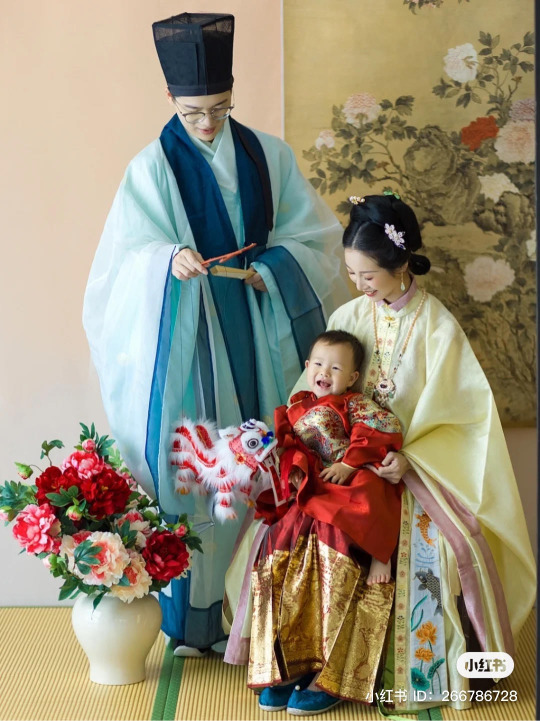
The term “hanfu” (traditional Chinese: 漢服, simplified Chinese: 汉服) literally means “Han clothing”, and refers to the traditional clothing of the Han Chinese people. “Han” (漢/汉) here refers to the Han Chinese ethnic group (not the Han dynasty), and “fu” (服) means “clothing”. As I explained in this post, the modern meaning of “hanfu” is defined by the hanfu revival movement and community. As such, there is a lot of gatekeeping by the community around what is or isn’t hanfu (based on historical circumstances, cultural influences, tailoring & construction, etc). This isn’t a bad thing - in fact, I think gatekeeping to a certain extent is helpful and necessary when it comes to reviving and defining historical/traditional clothing. However, this also led to the need for a similarly short, catchy term that would include all Chinese clothing that didn’t fit the modern definition of hanfu -- enter huafu.
The term “huafu” (traditional Chinese: 華服, simplified Chinese: 华服) as it is used today has a broader definition than hanfu. “Hua” (華/华) refers to the Chinese people (中华民族/zhonghua minzu), and again “fu” (服) means “clothing”. It is an umbrella term for all clothing that is related to Chinese history and/or culture. Thus all hanfu is huafu, but not all huafu is hanfu. Below are examples of Chinese clothing that are generally not considered hanfu by the hanfu community for various reasons, but are considered huafu:
1. Most fashions that originated during the Qing dynasty (1644–1911), especially late Qing, including the Qing aoqun & aoku for women, and the Qing changshan and magua for men. I wrote about whether Qing dynasty clothing can be considered hanfu here. Tangzhuang, which is an updated form of the Qing magua popularized in 2001, can also fit into this category. Below - garments in the style of Han women’s clothing during the Qing dynasty (清汉女装) from 秦綿衣莊 (1, 2).
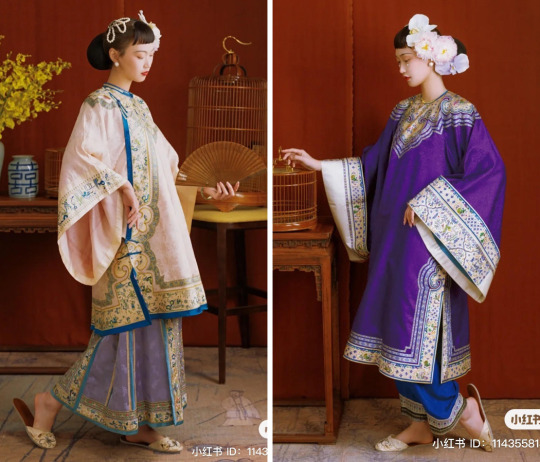
2. Fashions that originated during the Republican era/minguo (1912-1949), including the minguo aoqun & aoku and qipao/cheongsam for women, and the minguo changshan for men (the male equivalent of the women’s qipao). I wrote about why qipao isn’t considered hanfu here. Below - minguo aoqun (left) & qipao (right) from 嬉姷.

Below - Xiangsheng (crosstalk) performers Zhang Yunlei (left) & Guo Qilin (right) in minguo-style men’s changshan (x). Changshan is also known as changpao and dagua.
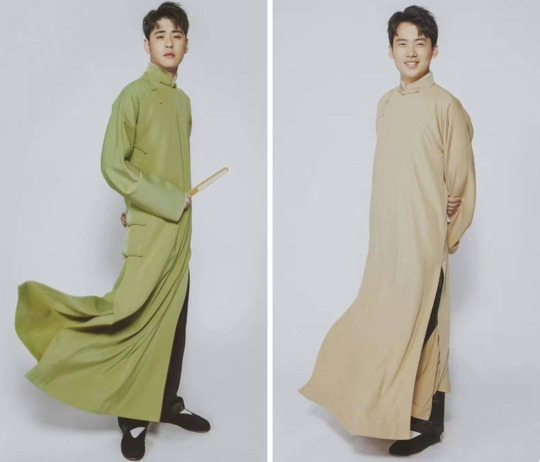
3. Qungua/裙褂 and xiuhefu/秀禾服, two types of Chinese wedding garments for brides that are commonly worn today. Qungua originated in the 18th century during the Qing dynasty, and xiuhefu is a modern recreation of Qing wedding dress popularized in 2001 (x). Below - left: qungua (x), right: xiuhefu (x).
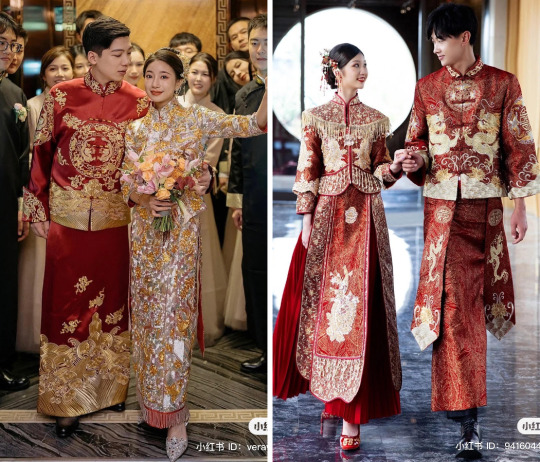
4. Modified hanfu (改良汉服/gailiang hanfu) and hanyuansu/汉元素 (hanfu-inspired fashion), which do not fit in the orthodox view of hanfu. Hanfu mixed with sartorial elements of other cultures also fit into this category (e.g. hanfu lolita). From the very start of the hanfu movement, there’s been debate between hanfu “traditionalists” and “reformists”, with most members being somewhere in the middle, and this discussion continues today. Below - hanyuansu outfits from 川黛 (left) and 远山乔 (right).

5. Performance costumes, such as Chinese opera costumes (戏服/xifu) and Chinese dance costumes. These costumes may or may not be considered hanfu depending on the specific style. Dance costumes, in particular, may have non-traditional alterations to make the garment easier to dance in. Dunhuang-style feitian (apsara) costumes, which I wrote about here, can also fit into this category. Below - left: Chinese opera costume (x), right: Chinese dance costume (x).
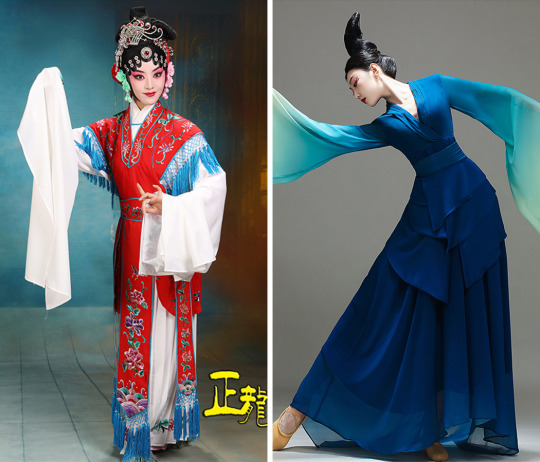
6. Period drama costumes and fantasy costumes in popular media (live-action & animation, games, etc.), commonly referred to as guzhuang/古装 (lit. “ancient costumes”). Chinese period drama costumes are of course based on hanfu, and may be considered hanfu if they are historically accurate enough. However, as I wrote about here, a lot of the time there are stylistic inaccuracies (some accidental, some intentional) that have become popularized and standardized over time (though this does seem to be improving in recent years). This is especially prevalent in the wuxia and xianxia genres. Similarly, animated shows & games often have characters dressed in “fantasy hanfu” that are essentially hanfu with stylistic modifications. Below - left: Princess Taiping in historical cdrama 大明宫词/Palace of Desire (x), right: Wei Wuxian and Lan Wangji in wuxia/xianxia cdrama 陈情令/The Untamed (x).

7. Any clothing in general that purposefully utilizes Chinese style elements (embroidery, fabrics, patterns, motifs, etc). Chinese fashion brand Heaven Gaia is a well-known example of this. Below - Chinese-inspired designs by Heaven Gaia (x).
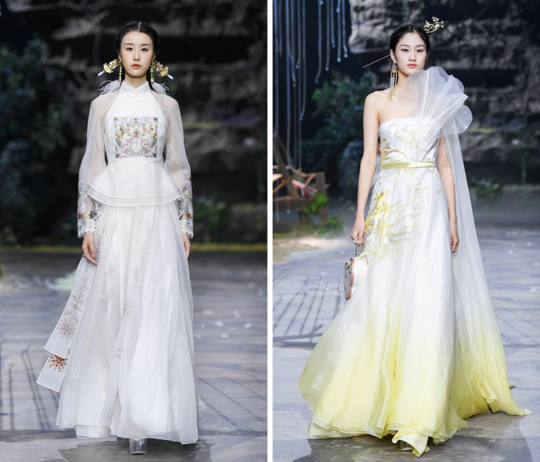
8. Technically, the clothing of China’s ethnic minorities also fit under the broad definition of huafu, but it’s rarely ever used in this way.
From personal observation, the term “huafu” is mainly used in the following situations:
1. Some large-scale events to promote Chinese clothing, such as the annual “华服日/Huafu Day”, will use “huafu” in their name for inclusivity.
2. For the same reason as above, Chinese clothing including hanfu will often be referred to as “huafu” on network television programs (ex: variety shows).
3. A few Chinese clothing shops on Taobao use “huafu” in their shop name. Two examples:
明镜华服/Mingjing Huafu - sells hanfu & hanyuansu.
花神妙华服/Huashenmiao Huafu - sells Qing dynasty-style clothing.
With the exception of the above, “huafu” is still very rarely used, especially compared to “hanfu”. It has such a broad definition that it’s just not needed in situations for which a more precise term already exists. However, I do think it’s useful as a short catch-all term for Chinese clothing that isn’t limited to the currently accepted definition of hanfu.
If anyone wants to add on or correct something, please feel free to do so! ^^
Hope this helps!
#happy 2023!#hanfu#huafu#terminology#language#hanfu movement#history#reference#ask#reply#>1000#chinese fashion#chinese culture#china
2K notes
·
View notes
Text
TTEOTM Easter Eggs Part 3 - Costume and Makeup Details
I love beautiful costumes, but even more when they tell a story! Here are a few of my observations. Did you spot anything else? (Spoilers!)
(1) The two outfits Ye Xiwu gifted Tantai Jin are both quilted. The purple costume is particularly unusual in that it's constructed like a blanket. In contrast, all his clothing in the hostage prince arc are not quite thick enough for Sheng kingdom's harsh winters. Ye Xiwu is literally bringing warmth to his life.
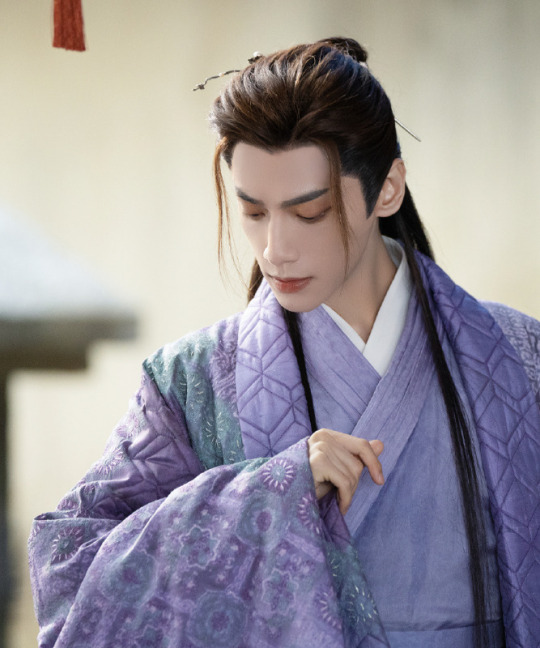

(2) TTJ and YXW wear similar costumes in their two love scenes - (1) Ep 2 - YXW's imagination of the drugged affair which led to their marriage and (2) Ep 39, where they finally consummated their marriage on screen. YXW wears the same pink costume. TTJ in different but identical-looking mustard yellow costumes.

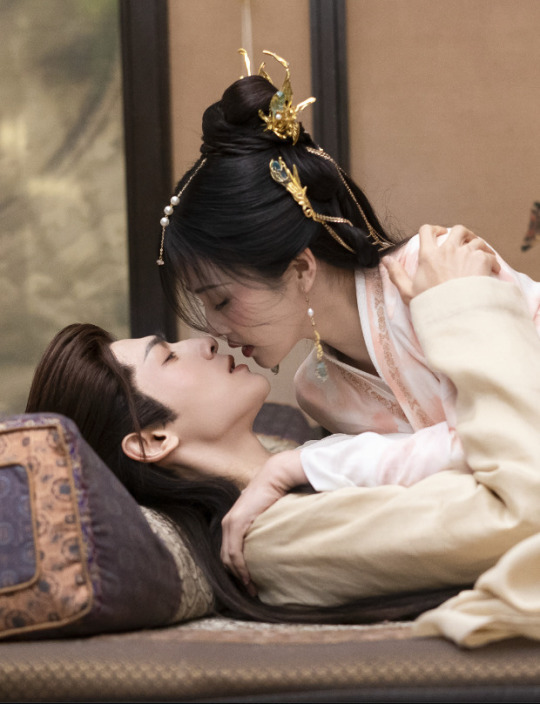
(3) Some viewers have criticized Ye Xiwu for not taking off hair accessories before going to bed, chalking it up to lazy filmmaking. This is not necessarily the case. In ancient China, upper class women did sleep with their hair-do and manage to keep elaborate designs in tack. How? By resting her neck, not her head, on the pillow.
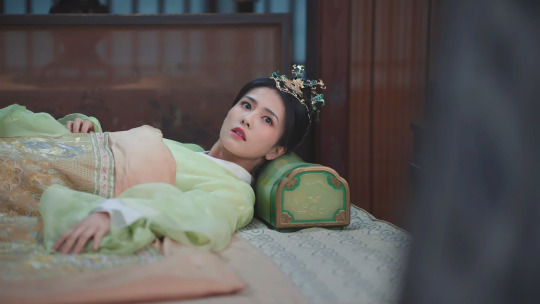
Ye Xiwu / Li Susu does go without hair accessories in a few occasions: when she is traveling, ill, depressed, and in mourning. It is most likely a creative choice to create a contrast between moments where her character is in control and powerful vs. vulnerable.
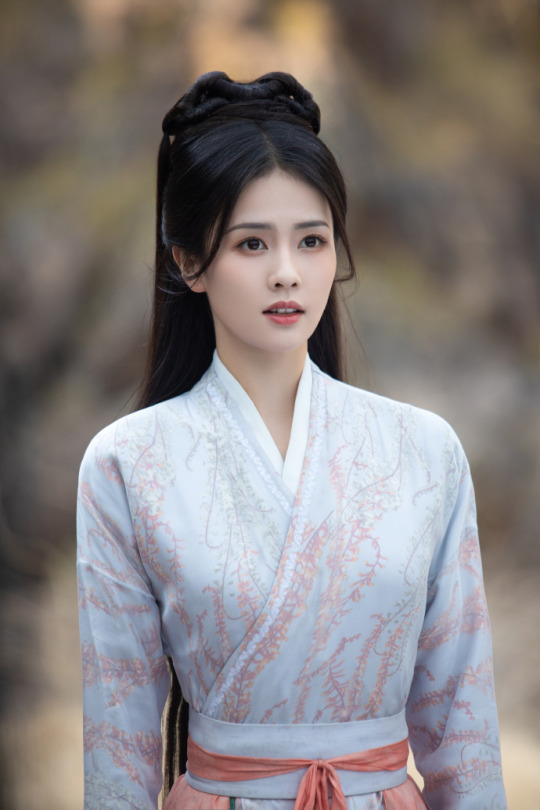


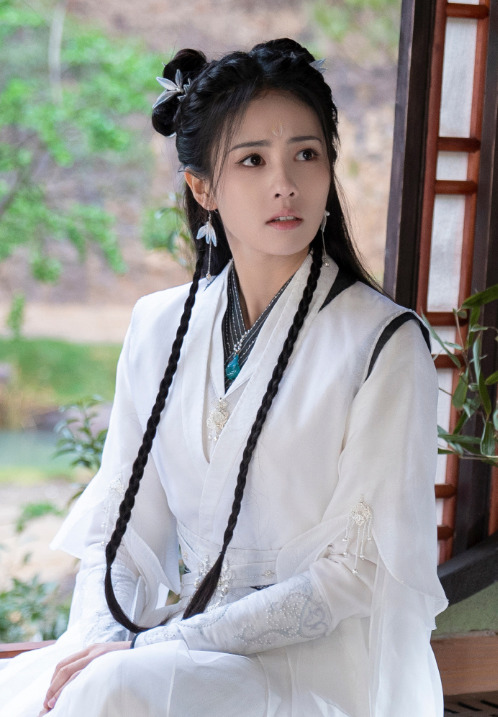
(4) All of Tantai Jin's female lieutenants wear red, from Pianran (after she starts working for him) to Siying and Monu. In fact, so does Tantai Minglang's lieutenant Fuyu. Red appears to be the career woman's color in this world!




(5) After Mingye falls in love with Sangjiu, he adds the red waist scarf belt that's part of his wedding dress on top of his normally blue outfit.

(6) The costume that Cang Jiumin (left) wears when refining the Dragonheart Shield echoes Mingye's costume (right) through the red/blue colors and collar design, reinforcing the connection between the two characters.
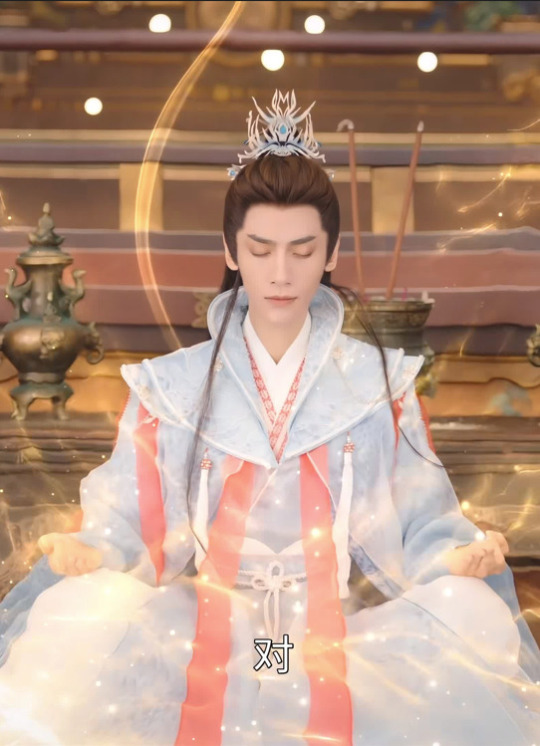

(7) The costumes in Bo're dream hint at the characters' true forms:
Mingye (dragon): dragonscale armour & patterned clothing
Sangjiu & Sangyou (clams): pearls & shell motifs
Tianhuan (snake): gold serpent hair crown & bracelets
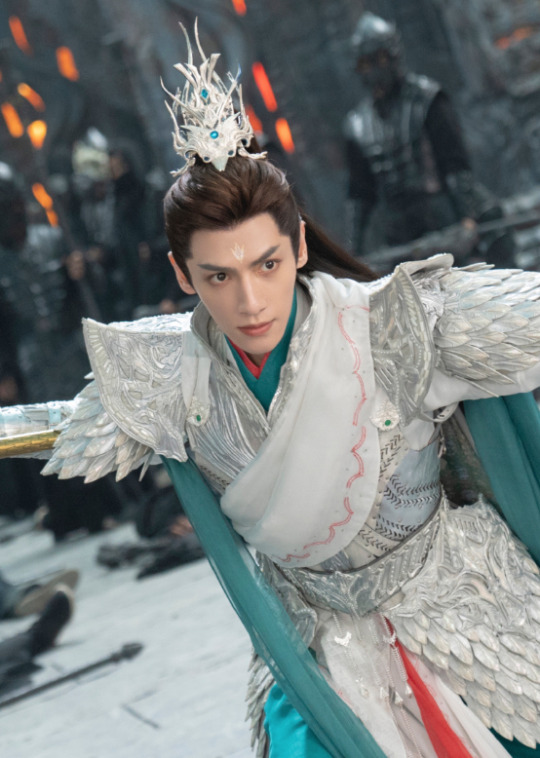


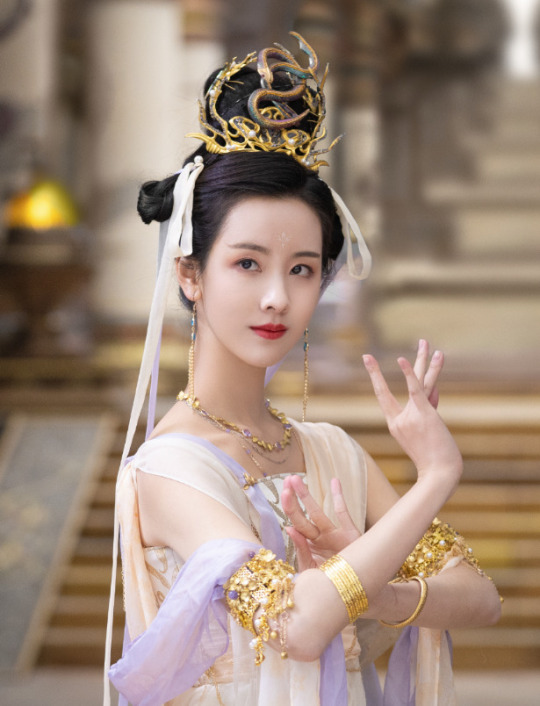
(8) Throughout the drama, only characters in the Upper Immortal Realm go full Dunhuang Feitian style, characterized by bandeaus, scarves, layers of drapery, sleeveless (similar to Indian clothing).

The style is used in formal occasions or to confer power or godliness. For example, Sangjiu goes Dunhuang with sleeveless draping outfits at her wedding and after she goes dark.
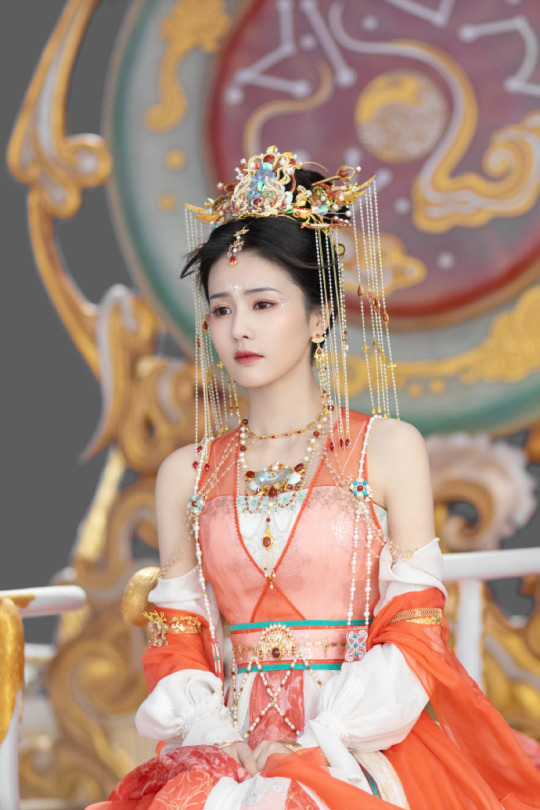

Similarly, when Susu and Tantai Jin become gods at the finale, they also take on a new Dunhuang-style outfit. In fact, the multi-color drapery of Tantai Jin's outfit seem to be an amalgamation of the fabric used in the twelve gods' outfits.

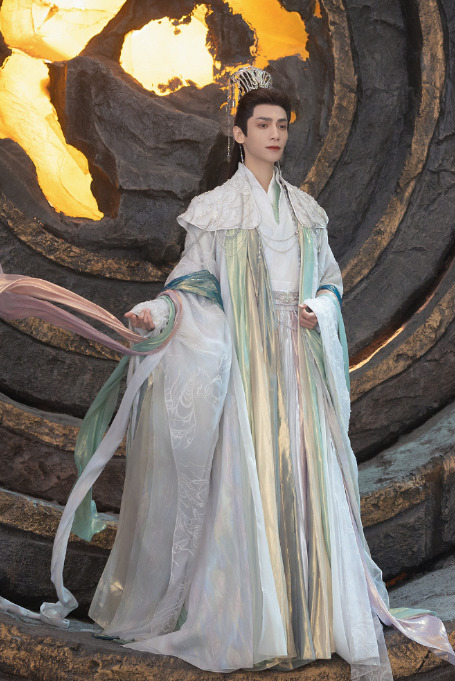
(9) Members of the Moon Tribe all wear long wavy hair, chunky metal and coin ornaments, and hair braiding.
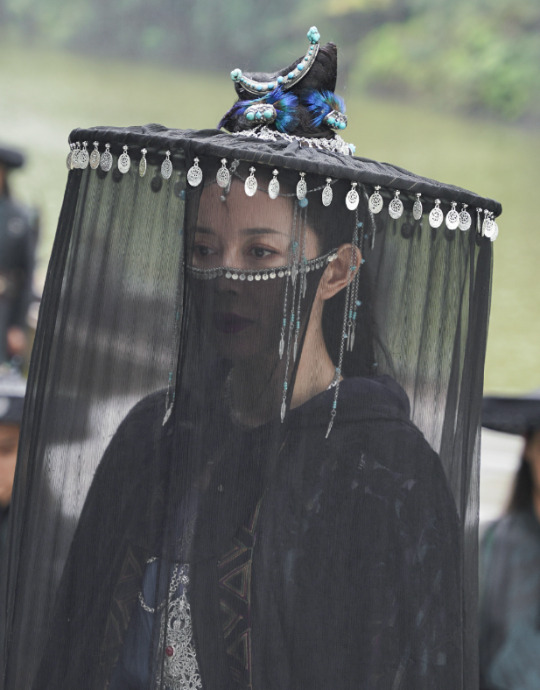

Tantai Jin follows the dress code when he stays with the Moon Tribe before entering the spiritual dimension.

Guess who also loves his wavy hair, metallic accessories, and leather? Of course it's the Ancient Devil God, again reminding viewers of his connection to the tribe.

Bonus: Luo Yunxi mentioned in an interview that his characters (hostage prince, emperor, Mingye, Devil Gods) all have different hairpieces/wigs. He had to take off and reglue his hair between scenes.
#till the end of the moon#luo yunxi#black moonlight holds the be script#cdrama#chang yue jin ming#chinese drama#tteotm#tantai jin#bai lu#ye xiwu#mingye#sangjiu
301 notes
·
View notes
Note
Hi! First of all I wanted to say that I only just found your account recently and it's very interesting, I love learning about other cultures and clothing has always been a big reason for that so I really appreciate the amount of research you put into your work!
Anyways, I'm also a big fan of Journey To The West and I found this photo depicting Princess Iron Fan that came from a 2010 Chinese opera performance "Monkey King: Flaming Mountain". Her outfit is very very pretty but I couldn't find any info on it no matter how hard I tried, the one thing I managed to find that was similar was called a feitian dress (I think, sorry if that's wrong), but they don't look quite the same as the one in this performance. I was wondering if you knew what it was called and if it has any historical accuracies behind the design of her outfit as well, thanks in advance! :)


Thank you so much for your kind words! I'm glad you're enjoying my blog.
So, I think you're on the right track with "feitian" dress. Another culture/ historical fashion blog, @ziseviolet, wrote an excellent post about feitian dress, its origins, and its modern versions that you should read here: https://www.tumblr.com/ziseviolet/672232299973296128/what-exactly-does-dunhuang-style-mean?source=share
Another thing to note is that it's a Chinese Opera performance, meaning that the costumes will blend the well-known character traits & signifiers from the original tale mixed with traditional Chinese Opera costumes/ accessories. As far as I could tell, Princess Iron Fan is some kind of demoness in the original story, and many gods/bodhisattvas/apsaras (i.e. feitian)/ demons were depicted wearing "feitian" style clothing to indicate their non-humanness to audiences.
We know that feitian style clothing isn't historically accurate and that many aspects of Chinese Opera costumes are also not historical, so there's not much else to find regarding this version of Princess Iron Fan's costume. I do agree that it's very pretty, but I don't think it has any special name or style other than "feitian." I hope you find this answer helpful! If not, see if @ziseviolet may have a better answer for you!
Regards,
Koikishu
51 notes
·
View notes
Text
Origins of the Pibo: Let’s take a trip along the Silk Road.
1. Introduction to the garment:
Pibo 披帛 refers to a very thin and long shawl worn by women in ancient East Asia approximately between the 5th to 13th centuries CE. Pibo is a modern name and its historical counterpart was pei 帔. But I’ll use pibo as to not confuse it with Ming dynasty’s xiapei 霞帔 and a much shorter shawl worn in ancient times also called pei.
Below is a ceramic representation of the popular pibo.
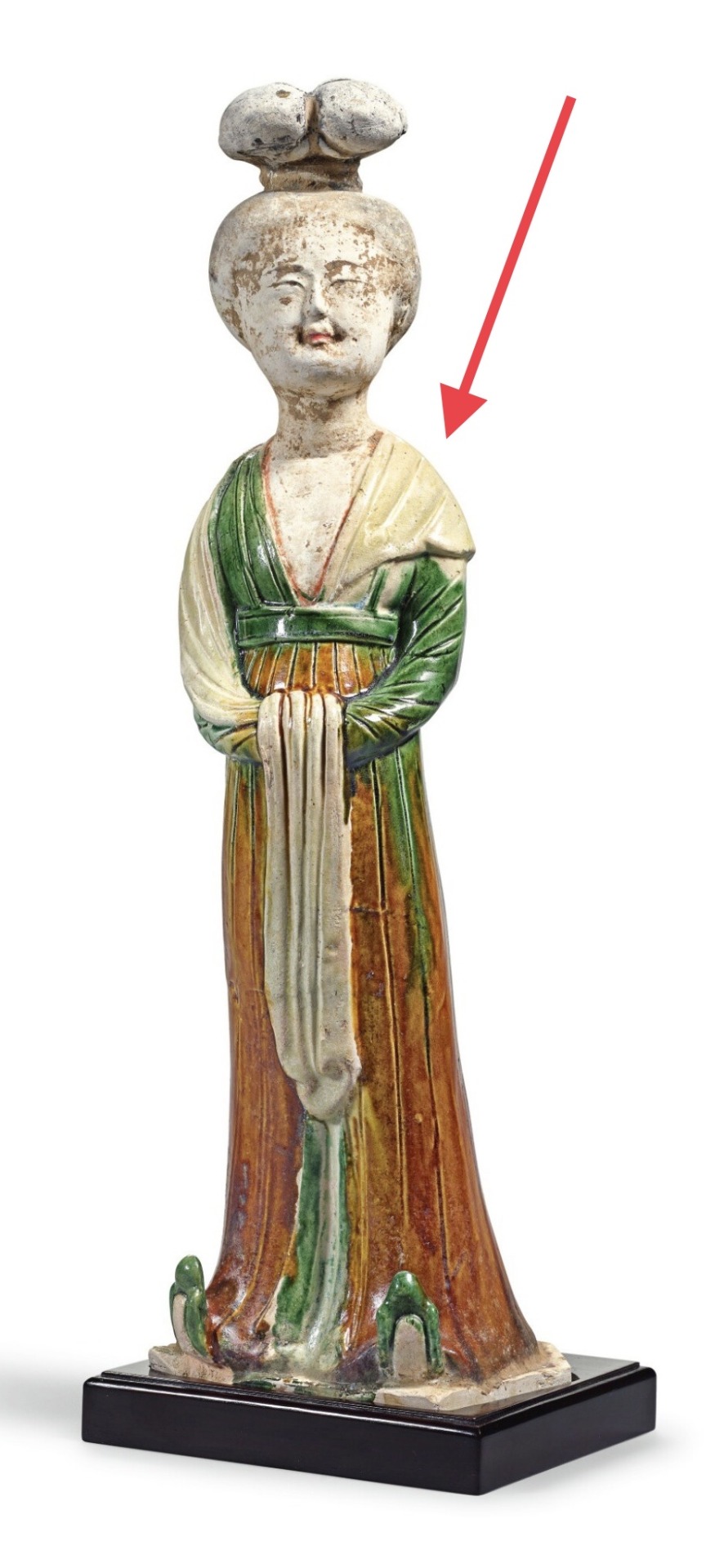
A sancai-glazed figure of a court lady, Tang Dynasty (618–690, 705–907 CE) from the Sze Yuan Tang Collection. Artist unknown. Sotheby’s [image source].
Although some internet sources claim that pibo in China can be traced as far back as the Qin (221-206 BCE) or Han (202 BCE–9 CE; 25–220 CE) dynasties, we don’t start seeing it be depicted as we know it today until the Northern and Southern dynasties period (420-589 CE). This has led to scholars placing pibo’s introduction to East Asia until after Buddhism was introduced in China. Despite the earliest art representations of the long scarf-like shawl coming from the Northern and Southern Dynasties period, the pibo reached its popularity apex in the Tang Dynasty (618–690 CE: 705–907 CE).
Academic consensus: Introduction via the Silk Road.
The definitive academic consensus is that pibo evolved from the dajin 搭巾 (a long and thin scarf) worn by Buddhist icons introduced to China via the Silk Road from West Asia.
披帛是通过丝绸之路传入中国的西亚文化, 与中国服饰发展的内因相结合而流行开来的一种"时世妆" 的形式. 沿丝绸之路所发现的披帛, 反映了丝绸贸易的活跃.
[Trans] Pibo (a long piece of cloth covering the back of the shoulders) was a popular female fashion period accessory introduced to China by West Asian cultures by way of the Silk Road and the development of Chinese costumes. The brocade scarves found along the Silk Road reflect the prosperity of the silk trade that flourished in China's past (Lu & Xu, 2015).
I want to add to the above theory my own speculation that, what the Chinese considered to be dajin, was most likely an ancient Indian garment called uttariya उत्तरीय.
2. Personal conjecture: Uttariya as a tentative origin to pibo.
In India, since Vedic times (1500-500 BCE), we see mentions in records describing women and men wearing a thin scarf-like garment called “uttariya”. It is a precursor of the now famous sari. Although the most famous depiction of uttariya is when it is wrapped around the left arm in a loop, we do have other representations where it is draped over the shoulders and cubital area (reverse of the elbow).
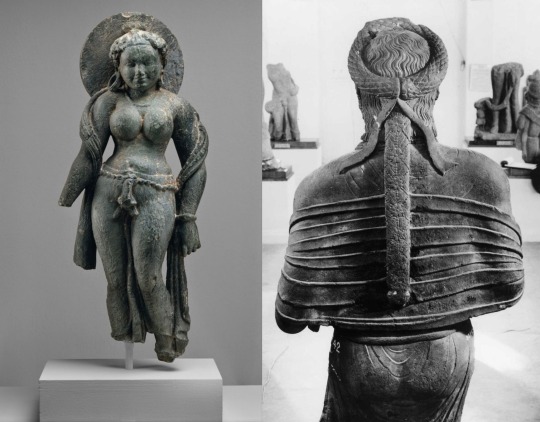
Left: Hindu sculpture “Mother Goddess (Matrika)”, mid 6th century CE, gray schist. Artist unknown. Looted from Rajasthan (Tanesara), India. Photo credit to Metropolitan Museum of Art, New York, United States [image source].
Right: Rear view of female statue possibly representing Kambojika, the Chief Queen of Mahakshatrapa Rajula, ca. 1st century CE. Artist unknown. Found in the Saptarishi Mound, Mathura, India. Government Museum, Mathura [image source].
Buddhism takes many elements from Hindu mythology, including apsaras अप्सरा (water nymphs) and gandharvas गन्धर्व (celestial musicians). The former was translated as feitian 飞天 in China. Hindu deities were depicted wearing clothes similar to what Indian people wore, among which we find uttariya, often portrayed in carvings and sculptures of flying and dancing apsaras or gods to show dynamic movement. Nevertheless, uttariya long predated Buddhism and Hinduism.
Below are carved representation of Indian apsaras and gandharvas. Notice how the uttariya are used.

Upper left: Carved relief of flying celestials (Apsara and Gandharva) in the Chalukyan style, 7th century CE, Chalukyan Dynasty (543-753 CE). Artist Unknown. Aihole, Karnataka, India. National Museum, New Delhi, India [image source]. The Chalukyan art style was very influential in early Chinese Buddhist art.
Upper right: Carved relief of flying celestials (gandharvas) from the 10th to the 12th centuries CE. Artist unknown. Karnataka, India. National Museum, New Delhi, India [image source].
Bottom: A Viyadhara (wisdom-holder; demi-god) couple, ca. 525 CE. Artist unknown. Photo taken by Nomu420 on May 10, 2014. Sondani, Mandsaur, India [image source].
Below are some of the earliest representations of flying apsaras found in the Mogao Caves, Gansu Province, China. An important pilgrimage site along the Silk Road where East and West met.
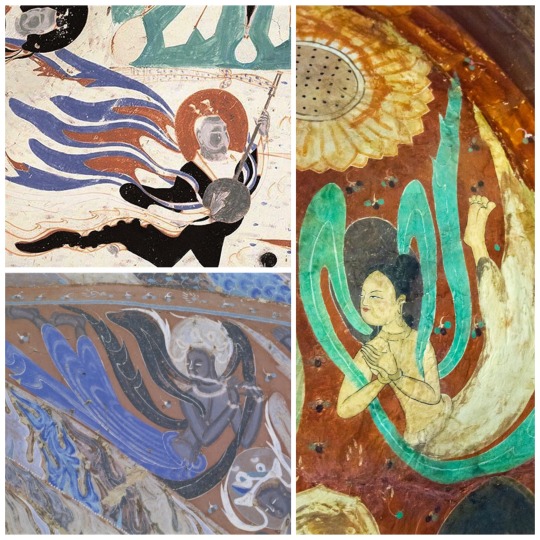
Left to right: Cave No. 461, detail of mural in the roof of the cave depicting either a flying apsara or a celestial musician. Western Wei dynasty (535–556 CE). Artist unknown. Mogao Grottoes, Dunhuang, China [image source].
Cave 285 flying apsara (feitian) in one of the Mogao Caves. Western Wei Dynasty (535–556 CE), Artist unknown. Photo taken by Keren Su for Getty Images. Mogao Grottoes, Dunhuang, China [image source].
Cave 249. Mural painting of feitian playing a flute, Western Wei Dynasty (535-556 CE). Image courtesy by Wang Kefen from The Complete Collection of Dunhuang Grottoes, Vol. 17, Paintings of Dance, The Commercial Press, Hong Kong, 2001, p. 15. Mogao Grottoes, Dunhuang, China [image source].
I theorize that it is likely that the pibo was introduced to China via Buddhism and Buddhist iconography that depicted apsaras (feitian) and other deites wearing uttariya and translated it to dajin.
3. Trickle down fashion: Buddhism’s journey to the East.
However, since Buddhism and its Indian-based fashion spread to West Asia first, to Sassanian Persians and Sogdians, it is likely that, by the time it reached the Han Chinese in the first century CE, it came with Persian and Sogdian influence. Persians’ fashion during the Sassanian Empire (224–651 CE) was influenced by Greeks (hellenization) who also had a a thin long scarf-like garment called an epliblema ἐπίβλημα, often depicted in amphora (vases) of Greek theater scenes and sculptures of deities.

Left to right: Dame Baillehache from Attica, Greece. 3rd century BCE, Hellenistic period (323-30 BCE), terracotta statuette. Photo taken by Hervé Lewandowski. Louvre Museum, Paris, France [image source].
Deatail view of amphora depicting the goddess Artemis by Athenian vase painter, Andokides, ca. 525 BCE, terracotta. Found in Vulci, Italy. Altes Museum, Berlin, Germany [image source].
Statue of a Kore (young girl), ca. 570 BCE, Archaic Period (700-480 BCE), marble. Artist unknown. Uncovered from Attica, Greece. Acropolis Museum, Athens, Greece [image source].
Detail view of Panathenaic (Olympic Games) prize amphora with lid, 363–362 BCE, Attributed to the Painter of the Wedding Procession and signed by Nikodemos, terracotta. Uncovered from Athens, Greece. J. Paul Getty Museum, Los Angeles, California, United States [image source].
Roman statue depicting Euterpe, muse of lyric poetry and music, ca. 2nd century CE, marble, Artist unknown. From the Villa of G. Cassius Longinus near Tivoli, Italy. Photo taken by Egisto Sani on March 12, 2012, Vatican Museums, Rome, Italy [image source].
Greek (or Italic) tomb mural painting from the Tomb of the Diver, ca. 470 BCE, fresco. Artist unknown. Photo taken by Floriano Rescigno. Necropolis of Paestum, Italy [image source].
Below are Iranian and Iraqi period representations of this long thin scarf.

Left to right: Closeup of ewer likely depicting a female dancer from the Sasanian Period (224–651 CE) in ancient Persia , Iran, 6th-7th century CE, silver and gilt. Artist unknown. Mary Harrsch. July 10, 2015. Arthur M. Sackler Gallery of Asian Art, Smithsonian, Washington D.C [image source].
Ewer with nude dancer probably representing a maenad, companion of Dionysus from the Sasanian Period (224–651 CE) in ancient Persia, Iran, 6th-7th century CE, silver and gilt. Artist unknown. Mary Harrsch. July 16, 2015. Arthur M. Sackler Gallery of Asian Art, Smithsonian, Washington D.C [image source].
Painting reconstructing the image of unveiled female dancers depicted in a fresco, Early Abbasid period (750-1258 CE), about 836-839 CE from Jawsaq al-Khaqani, Samarra, Iraq. Museum of Turkish and Islamic Art, Istanbul [image source].
The earliest depictions of Buddha in China, were very similar to West Asian depictions. Ever wonder why Buddha wears a long draped robe similar to a Greek himation (Romans called it toga)?
Take a look below at how much the Greeks influenced the Kushans in their art and fashion. The top left image is one of the earliest depictions of Buddha in China. Note the similarities between it and the Gandhara Buddha on the right.
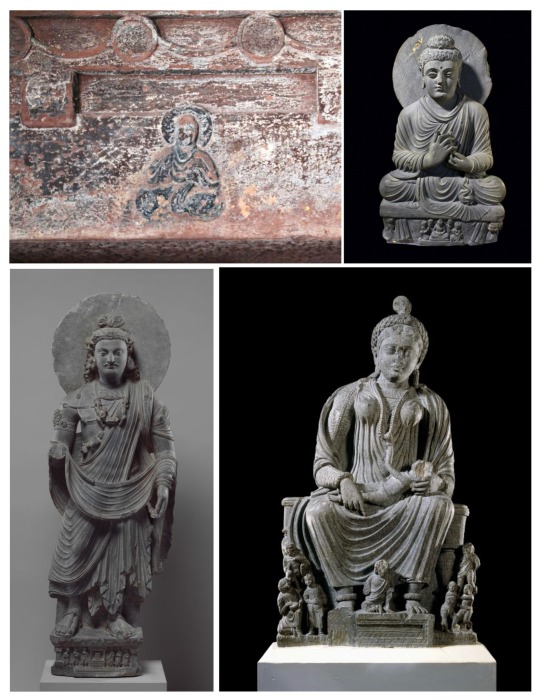
Left: Seated Buddha, Mahao Cliff Tomb, Sichuan Province, Eastern Han Dynasty, late 2nd century C.E. (photo: Gary Todd, CC0).
Right: Seated Buddha from Gandhara, Pakistan c. 2nd–3rd century C.E., Gandhara, schist (© Trustees of the British Museum)
Standing Bodhisattva Maitreya (Buddha of the Future), ca. 3rd century, gray schist. From Gandhara, Pakistan. Image credit to The Metropolitan Museum of Art, New York City, United States [image source].
Statue of seated goddess Hariti with children, ca. 2nd to 3rd centuries CE, schist. Artist unknown. From Gandhara, Pakistan. The British Museum, London, England [image source].
Before Buddhism spread outside of Northern India (birthplace), Indians never portrayed Buddha in human form.
Early Buddhist art is aniconic, meaning the Buddha is not represented in human form. Instead, Buddha is represented using symbols, such as the Bodhi tree (where he attained enlightenment), a wheel (symbolic of Dharma or the Wheel of Law), and a parasol (symbolic of the Buddha’s royal background), just to name a few. […] One of the earliest images [of Buddha in China] is a carving of a seated Buddha wearing a Gandharan-style robe discovered in a tomb dated to the late 2nd century C.E. (Eastern Han) in Sichuan province. Ancient Gandhara (located in present-day Afghanistan, Pakistan, and northwest India) was a major center for the production of Buddhist sculpture under Kushan patronage. The Kushans occupied portions of present-day Afghanistan, Pakistan, and North India from the 1st through the 3rd centuries and were the first to depict the Buddha in human form. Gandharan sculpture combined local Greco-Roman styles with Indian and steppe influences (Chaffin, 2022).
In the Mogao Caves, which contain some of the earliest Buddhist mural paintings in China, we see how initial Chinese Buddhist art depicted Indian fashion as opposed to the later hanfu-inspired garments.

Left to right: Cave 285, detail of wall painting, Western Wei dynasty (535–556 CE). Mogao Grottoes, Dunhuang, China. Courtesy the Dunhuang Academy [image source]. Note the clothes the man is wearing. It looks very similar to a lungi (a long men’s skirt).
Photo of Indian man sitting next to closed store wearing shirt, scarf, lungi and slippers. Paul Prescott. February 20, 2015. Varanasi, India [image source].
Cave 285, mural depiction of worshipping bodhisattvas, 6th century CE, Wei Dynasty (535-556 A.D.), Unknown artist. Mogao Grottoes, Dunhuang, China. Notice the half bow on his hips. That is a common style of tying patka (also known as pataka; cloth sashes) that we see throughout Indian history. Many of early Chinese Buddhist paintings feature it, including the ones at Mogao Caves.
Indian relief of Ashoka wearing dhoti and patka, ca. 1st century BC, Unknown artist. From the Amaravathi village, Guntur district, Andhra Pradesh, India. Currently at the Guimet Museum, Paris [image source].
Cave 263. Mural showing underlying painting, Northern Wei Dynasty (386–535 CE). Artist Unknown. Picture taken November 29, 2011, Mogao Grottoes, Dunhuang, China [image source]. Note the pants that look to be dhoti.
Comparison photo of modern dhoti advertisement from Etsy [image source].
Spread of Buddhism to East Asia.

Map depicting the spread of Buddhism from Northern India to the rest of Asia. Gunawan Kartapranata. January 31, 2014 [image source]. Note how Mahayana Buddhism arrived to China after passing through Kushan, Bactrean, and nomadic steppe lands, absorbing elements of each culture along the way.
Wealthy Buddhist female patrons emulated the fantasy fashion worn by apsaras, specifically, the uttariya/dajin and adopted it as an everyday component of their fashion.

Cave 285. feitian mural painting on the west wall, Western Wei Dynasty (535–556 CE). Artist unknown. Mogao Grottoes, Dunhuang, China [image source].
Cave 285. Detail view of offering bodhisattvas (bodhisattvas making offers to Buddha) next to the phoenix chariot on the Western wall of the cave. Western Wei Dynasty (535–556 CE). Artist unknown. Mogao Grottoes, Dunhuang, China [image source].
Cave 61 Khotanese (from the kingdom of Khotan 于阗 [56–1006 CE]) donor ladies, ca. 10th century CE, Five Dynasties period (907 to 979 CE). Artist unknown. Picture scanned from Zhang Weiwen’s Les oeuvres remarquables de l'art de Dunhuang, 2007, p. 128. Uploaded to Wikimedia Commons on October 11, 2012 by Ismoon. Mogao Grottoes, Dunhuang, China [image source].
Detail view of Ladies Adorning Their Hair with Flowers 簪花仕女图, late 8th to early 9th century CE, handscroll, ink and color on silk, Zhou Fang 周昉 (730-800 AD). Liaoning Provincial Museum, Shenyang, China [image source].
Therefore, the theory I propose of how the pibo entered East Asia is:
India —> Greek influenced West Asia (Sassanian Persians, Sogdians, Kushans, etc…) —> Han China —> Rest of East Asia (Three Kingdoms Korea, Asuka Japan, etc…)
Thus, the most likely theory, in my person opinion, is Buddhist iconography depicting uttariya encountered Greek-influenced West Asian Persian, Sogdian, and Kushan shawls, which combined arrived to China but wouldn’t become commonplace there until the explosion in popularity of Buddhism from the periods of Northern and Southern Dynasties to Song.
References:
盧秀文; 徐會貞. 《披帛與絲路文化交流》 [The brocade scarf and the cultural exchanges along the Silk Road]. 敦煌研究 (中國: 敦煌研究編輯部). 2015-06: 22 – 29. ISSN 1000-4106.
#hanfu#chinese culture#chinese history#buddhism#persian#sogdian#kushan#gandhara#indian fashion#uttariya#pibo#history#asian culture#asian art#asian history#asian fashion#east asia#south asia#india#pakistan#iraq#afghanistan#sassanian#silk road#fashion history#tang dynasty#eastern han dynasty#cultural exchange#greek fashion#mogao caves
283 notes
·
View notes
Photo
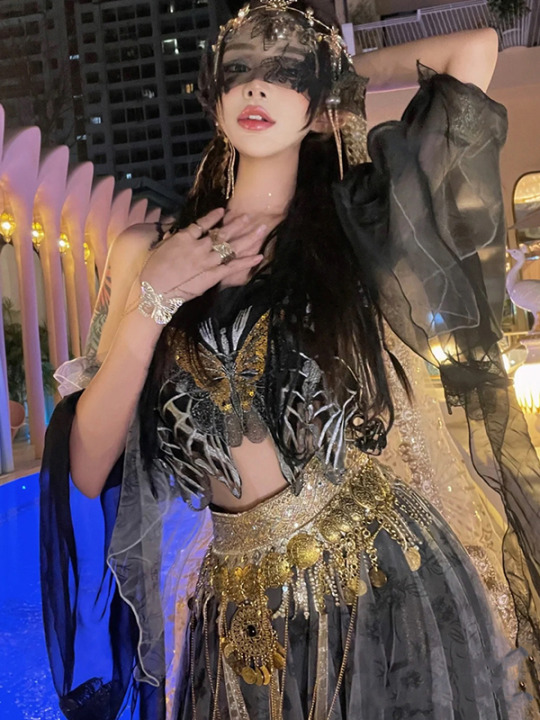


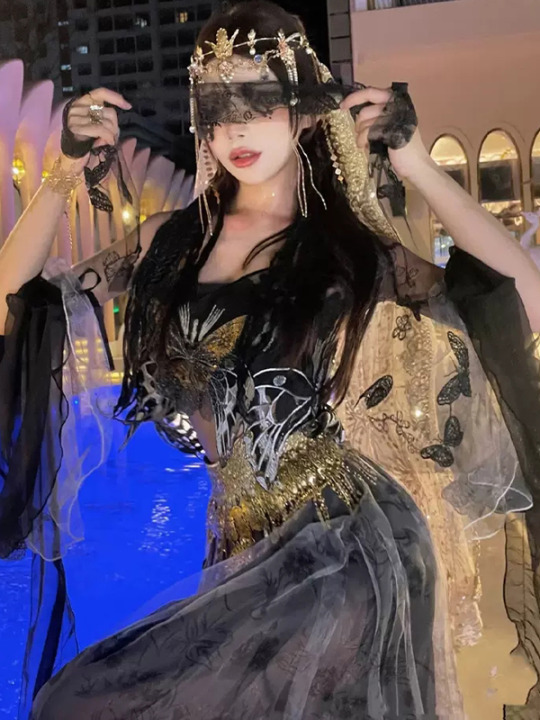
Chinese Hanfu Dance Dunhuang Style Feitian Dress
Dunhuang style Hani Exotic Costume;
Pair with armbands and waist chains;
High quality fabric feels comfortable against the skin.
42 notes
·
View notes
Video
chinese gudian dance / classical dance by 嘎嘎灵
#china#video#dance#I prefer to call it gudian dance#the transliteration of the word 古典#because it's kind of different from classical#chinese gudian dance is a very generalized concept#with costumes referencing the hanfu style and some referencing the feitian style#often incorporating many movements from martial arts acrobatics and chinese opera#some of the basic movements of large performances are influenced by ballet#I personally prefer choreographies that are not influenced by elements such as ballet but inspired by ancient chinese culture#like 玉人舞 yu-ren-wu and 丽人行 li-ren-xing#this girl's dance is more like the one I'm talking about#very pretty
1K notes
·
View notes
Note
Hi, weird question but i noticed that a lot of buddhist-themed hanfu don't really seem to resemble 'normal' hanfu? Like for example, chinese depictions of feitian (apsaras) often show them in pants and bandeaus that show indian influences. Is that still considered hanfu, or is there a different chinese term for that kind of clothing?
Hi! Thanks for the question! No it is not a weird question.

“Feitian” like above are often based on the aesthetic of Dunhuang murals.
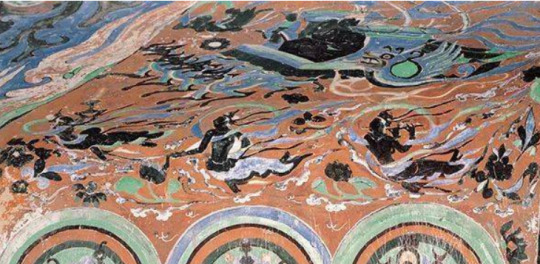
隋 莫高窟401窟 北壁龛顶 Feitian mural from Sui dynasty
I wouldn’t consider them hanfu. It could be called 影楼/Yǐnglóu (”photography studio”) because they only existed in studio shots, but 影楼 have a derogatory sense among hanfu wearers... Perhaps 古装/Gǔzhuāng (”ancient costume”) or 表演服/Biǎoyǎn fú (”performance clothing”) as dancers also wear something like this. Sometimes I saw the word 神仙装Shénxiān zhuāng (”costumes of the immortals”) was used.
Hanfu inspired by feitian usually consists of U-shape collar half-sleeve set (complete with pibo) such as the one below by 裳宫语汉服店.

(反弹琵琶 Playing pipa behind one’s back is a must have pose.)
Additional reading:
敦煌壁画中"飞天"到底是何方神圣? This is a post in Chinese that introduced different depictions of feitian from Sui Dynasty to Yuan Dynasty.
Ziseviolet’s feitian tag
280 notes
·
View notes
Text
Back on my “Feeling like I was mandala effected” bullshit. So there’s this scarf thing that shows up in Asian art, primarily on the various memetic descendants of Apsaras: Feitian in China, Dakini in Tibet, and Tennyo in Japan (though not on the apsaras themselves), and sometimes on other gods/immortals/etc. It doesn’t seem to have a name, though it’s a component of the “hagoromo” of the Tennyo.

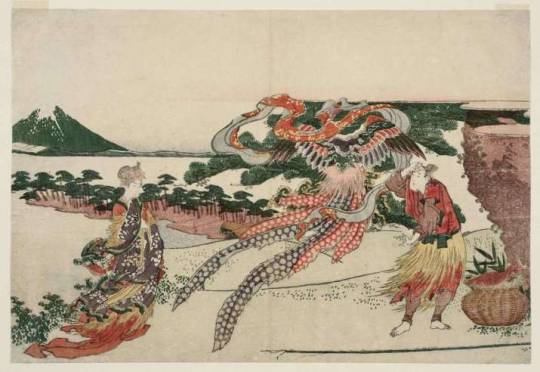
(In the second is a fisherman holding the entire hagoromo for selkie style reasons: the Tennyo can’t return to heaven without her robe.)
The mandala slide is this: I have such strong memories of reading about this iconography reaching the west, and appearing in all kinds of images of Greek goddesses and nymphs (and even continuing into Renaissance depictions of saints), where it was given a specific name that sounded kind of like “veil” (I wanna say “velifex”).
There was a whole “ancient aliens” conspiracy implying that this similarity in depictions meant people were visited by actual transcendant beings that had this as part of their costume (instead of, you know, visual references that look cool spread?).
After so much fruitless searching for examples of the Western version I’m starting to lean towards this all being a dream or brain malfunction, but it still stands out so clearly in my memory.
#I also mandala slid from a world where it was called mandala sliding/effect instead of mandela sliding/effect#curiously though it was still a berenstain timeline#:P#words#I think you'll find that 'mandala effected' is perfect grammatical: I was created (in this world) by a mandala :P
4 notes
·
View notes
Note
Hi!! My fun fact is I went down a research rabbithole at like midnight last night and I'm now about 90% sure the thavnairian bustier and its accompanying elements were partially inspired by dunhuang feitian costumes - costume inspired by the murals of feitian, flying celestials in Buddhism skilled in song and dance!! the costumes folk put together in more modern eras take a lot of inspiration from more Indian clothing pieces since there's a lot of Indian influences in the murals, which would lend itself well to inspiration since Thavnair and the dancer class have a lot of Indian influences, such as the architecture in new locations and Chakrams being a weapon originating in India!! Obviously not every costume is an exact match but there's some with a Strong resemblance (the ones with the same elaborate, jewelled neck piece) that led me down this research path to begin with - this isn't my starting point but I do think it shows the visual similarities really nicely, as well as just being really beautiful!! if the link in the "this" doesn't actually link please tell me and I'll send another ask with the link straight up instead
All of this doesn't necessarily add anything specific to what we know of the world, I just thought it was really interesting and made the thavnairian bustier click a lot more for me as a game costume inspired by real world pieces instead of like. what if dancer sexi nlkjbh
OHHH interesting!! i like seeing the irl stuff that ffxiv takes inspo from, and while I knew that Thavnir is based heavily on India i didn't know about the bustier specifically, so thats neat :]
for some context on why I was down that research rabbit hole to begin with I'm studying for a costume design (for fim and television) degree!! which. the fact that exists also qualifies as a fun fact I think, but yea that's why my brain grabs and shakes Clothing Facts like a doggy with its favourite chew toy ✌
YOOOOOOOO COSTUME DESIGN DEGREE?? thats so cool and fun!!!
#a lot of endwalker has heavy buddhist influences but thats a discussion for a different time#costume design degree sounds so much more fun than polisci#i am a suffering polisci degree but at least i can think a little too hard about the governmental structures of ffxiv OTL#zapphi talks#ffxiv#world building#ish
5 notes
·
View notes
Text
re: characters in joyful reunion though
It’s funny how English readers also quickly fall into the 1) Lang Junxia can do no wrong 2) Wu Du who? pattern much like the Chinese readers
Feitian designed it that way. Lang Junxia gets a costume change and a whole paragraph about how beautiful he is every single time he makes an appearance, and meanwhile Wu Du wears black I guess.
#fox text#joyful reunion related#Wu Du saved Li Jianhong's life once#flying to the rescue#saved duan ling's life twice#but he's still chopped liver#anyway back to work
5 notes
·
View notes
Note
Hiya! I’ve been extremely interested in Cdrama’s as of late and the costumes! Now in some of these dramas there are dancing scenes. But I saw that not all the dancing scenes are done in chinese clothes. I saw one scene where they wore a ‘bedlah’. Can I get your input wether this is just modern aesethic or not. Thank you for your time in answering our asks!
Hi, thanks for the question!
I know what you’re referring to - in Chinese historical costume (guzhuang) dramas, you can occasionally see characters wearing bedlahs or bedlah-like outfits for dance scenes. Example below - a character wearing bedlah for a dance scene in historical Cdrama Myth of Sword (x):

Bedlahs typically show up as dance costumes in historical Cdramas for the following reasons:
To give the dance a seductive/sensual air (of course this can be achieved with Chinese clothing, but bedlahs add an additional element of mystery and/or “exoticness”)
To suggest/signify Xiyu influence. Xiyu (西域), lit. “Western Regions”, was a historical name specified in the Chinese chronicles between the 3rd century BC to the 8th century AD that referred to the regions west of Yumen Pass, most often Central Asia or sometimes more specifically the easternmost portion of it (e.g. Altishahr or the Tarim Basin in southern Xinjiang), though it was sometimes used more generally to refer to other regions to the west of China as well, such as the Indian subcontinent (as in the novel Journey to the West)
For example, Tang dynasty-set Cdrama Beauties in the Closet features a bedlah dance scene, in which animal spirits disguised as women perform a dance to seduce the emperor (x). The Tang dynasty is famous for its Silk Road trade route that enabled strong relations with the empires to its west (ex: Byzantine, Persian, Arabian). The Tang capital Chang'an became an international metropolis, and foreign clothing & hairstyles became trendy. In Chang’an and Luoyang, Turkish and Persian fashions were highly sought after (x). Thus, the bedlahs in this scene serve to emphasize the seductiveness of the dance, as well as make a nod to the multicultural nature of Tang society:
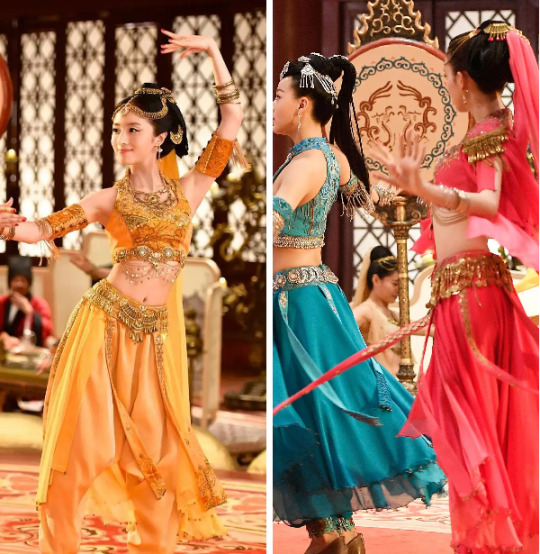
Another example comes from the historical Cdrama The Great Dunhuang, which is based on the history of the oasis city of Dunhuang, which lies on the ancient Silk Road. In this scene, Meiduo, a princess from the ancient Kingdom of Khotan, dances a feitian (apsara) dance in feitian costume (x). Feitian costumes as depicted in Chinese media have similarities with bedlah, as can be seen below:
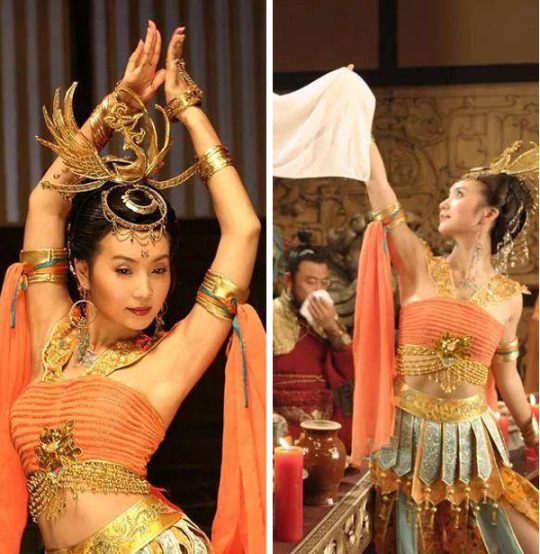
With all that said, though, the use of bedlahs in historical Cdrama costuming is still a modern aesthetic, due to the simple fact that the bedlah as we know it today is a modern 20th-century Egyptian belly dance costume influenced by European theatrical attire (1/2):
“The bedlah is essentially a Westernized creation, though not a wholly Western creation. What really cinched its iconic popularity in dance was the golden age of Egyptian Cinema in the 50s-70s, when Egyptian movies still largely cast professional dancers for dance roles. These Egyptian dancers, directors, and costumers sought inspiration from Hollywood and American culture - the bedlah is basically an Egyptianized iteration of the types of costuming that American dancers and showgirls were wearing. (Think Vegas, burlesque, cabaret, lounge and nightclub culture, in addition to movies/popular music culture.)” (Source)
Needless to say, this particular type of outfit did not even exist prior to the 1900s, much less during the Tang dynasty.
So why do they show up in historical Cdramas? As I’ve mentioned many times before (1/2/3), historical Chinese dramas tend to take a lot of liberties in their costume design. And indeed, this is one of those cases. I chalk it up to a combination of trying to appeal to modern audience’s aesthetics/expectations & lack of resources/attention. Researching & creating historically accurate outfits is a lot more difficult than slapping on a bedlah and calling it a day. ¯\_(ツ)_/¯
To be fair, this misunderstanding is a worldwide phenomenon, not just a Chinese one. For example, I don’t think it’s an exaggeration to say that Disney’s depiction of Princess Jasmine in a bedlah in Aladdin played a huge role in propagating the perception that the bedlah was an actual “ancient” historic outfit. This influence is especially noticeable in the recent Chinese “Xiyu aesthetic” fashion trend. Below are two Xiyu-style outfits with the theme “Loulan Princess” (the Loulan Kingdom was an ancient kingdom based around an important oasis city along the Silk Road) (x):

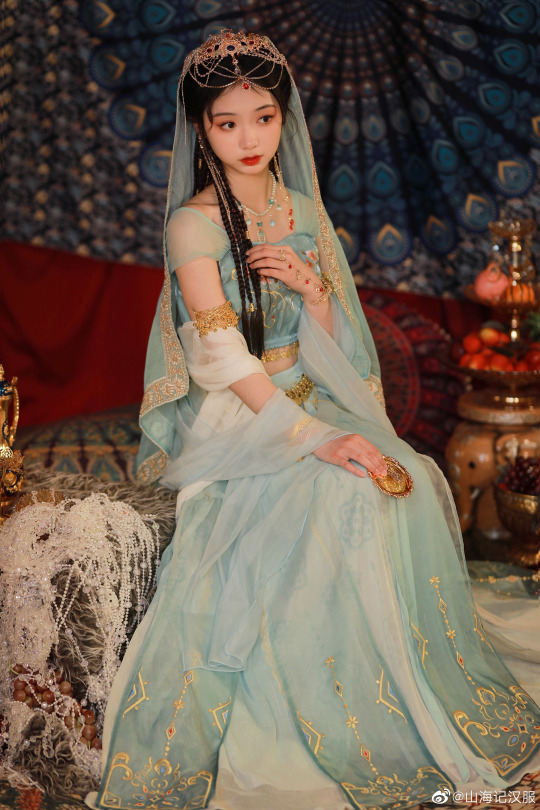
The “Princess Jasmine effect” is quite strong, wouldn’t you say? :P
For culturally/historically accurate Chinese dance clothes, please see my dance & dance hanfu tags.
If anyone wants to share more information, please do. Hope this helps!
351 notes
·
View notes
Photo

Jinx wearing Robin’s costume. Some inspiration for the next chapter of the Jinx/Robin fic I’m working on.
2011MAR20 Jinx by feitian
1 note
·
View note
Text
Black hang tag string
Accessories are growing and changing along with the history of clothing.
In the era of blood drinking, when people wear leaves and hides, the vines used for binding are accessories.

The use of accessories in Chinese ancient costumes is less, mainly ropes. In the Tang Feitian image, the flying ribbon is the ultimate embodiment of ancient accessories decoration.
From the Ming and Qing Dynasties, accessories began to be widely used. This is mainly due to the complex and exquisite reasons people have for the decorative effect of clothing. Accessories at this time mainly reflected in the embroidery, Suzhou embroidery is the peak of the development of clothing accessories in the Ming and Qing Dynasties. Usually feathers and jade are often sewn on clothes for decoration.
In modern times, western clothing was introduced into China. Accessories become exceptionally rich. People began to use buttons to dress extensively.
At the beginning of this century, the invention of the zipper was the most important event in the history of accessories. Until today is still the most important accessories.
Due to the pursuit of decorative effects, accessories have changed from functional core to decorative effect as the core. For example, decorative buckles, hot drilling, beads, rivets, laces, leather labels, black hang tag string etc. are all used as decorative accessories.
0 notes
Note
What exactly does Dunhuang style mean?
Hi, thanks for the question! (x)

Dunhuang/敦煌 style refers to the art, fashion, and culture depicted in the Dunhuang Murals/敦煌壁画 of China, which are located in the Mogao Caves in Dunhuang, Gansu Province. From the 4th to 14th century, the caves were constructed by Buddhist monks to serve as shrines with funds from donors. These caves were elaborately painted, the cave paintings and architecture serving as aids to meditation, visual representations of the quest for enlightenment, and teaching tools for Buddhist beliefs and stories. The major caves were sponsored by patrons such as important clergy, local ruling elite, foreign dignitaries, as well as Chinese emperors (x). Below - painting from the Dunhuang Murals (x):
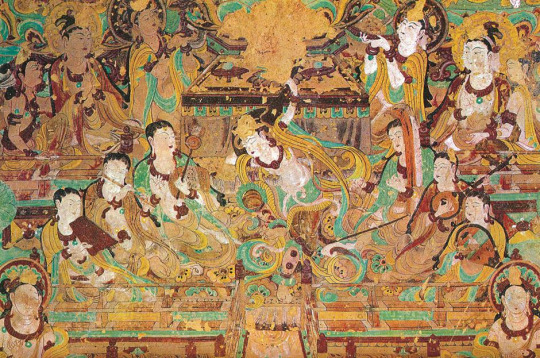
Dunhuang-style (敦煌风) hanfu refers to hanfu that is recreated from, based on, and/or inspired by the Dunhuang Murals. Inspiration is typically derived from two types of figures depicted in the paintings: cave patrons/donors & Feitian (apsaras).
The Dunhuang Murals depict many patrons & donors of the caves, people of high standing in society dressed in elaborate garments. You can see many hanfu recreations of the patrons in my dunhuang tag. The photo at the top of this post is a recreation of a patron. Additional examples below (1, 2, 3, 4):
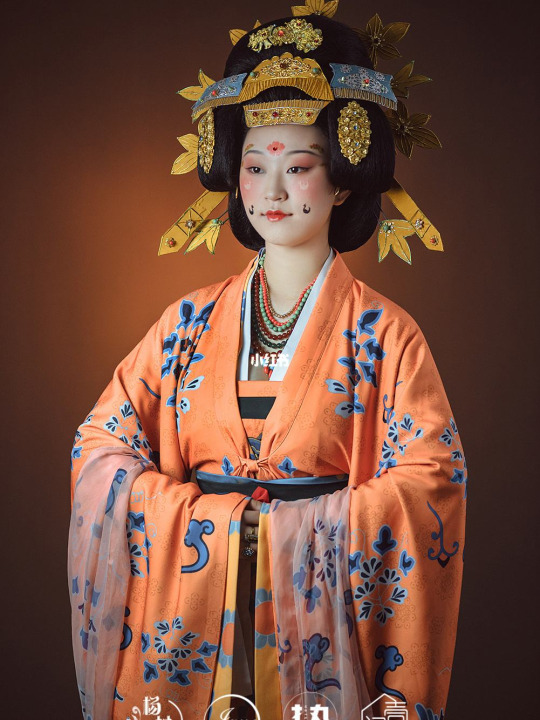
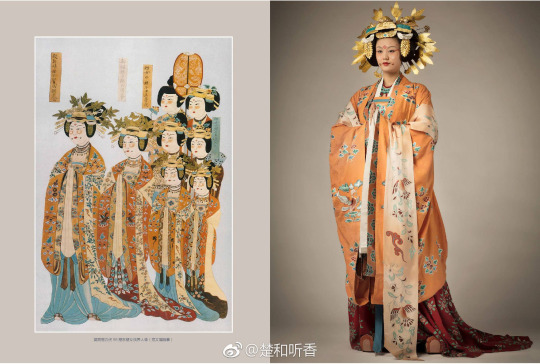
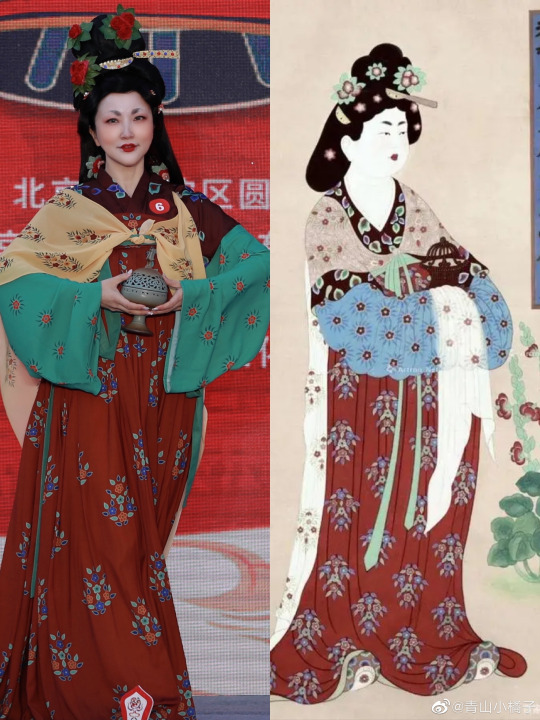
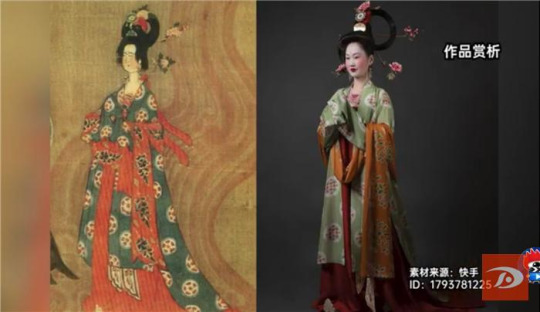
The second major source of inspiration for Dunhuang-style hanfu is Feitian/飞天. Feitian is the Chinese word for apsara, which are beautiful flying celestials in Buddhism, skilled in music and dance. It is estimated that there are more than 4,500 flying apsaras painted in the 270 plus Mogao Caves. Below - depictions of Feitian in Dunhuang Murals (x):
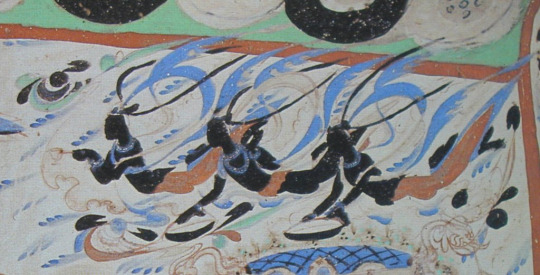
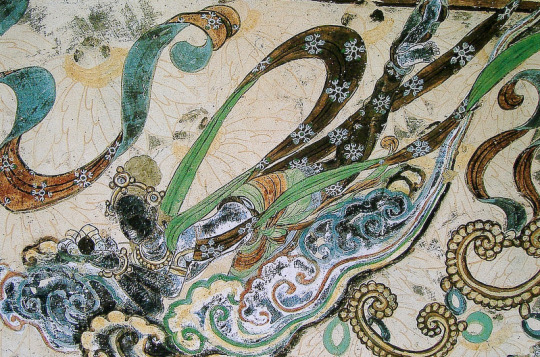
The Feitian in the paintings aren’t depicted wearing historical Chinese hanfu, but rather non-realistic fantastical garments common in Buddhist art. Thus, Feitian-style hanfu is not, strictly speaking, recreating the clothing of Feitian, but rather imitating it using hanfu garments. Feitian-style hanfu typically consists of u-collar, half-sleeve, Tang dynasty-style sets. Below - hanfu based on the Feitian aesthetic (1, 2):

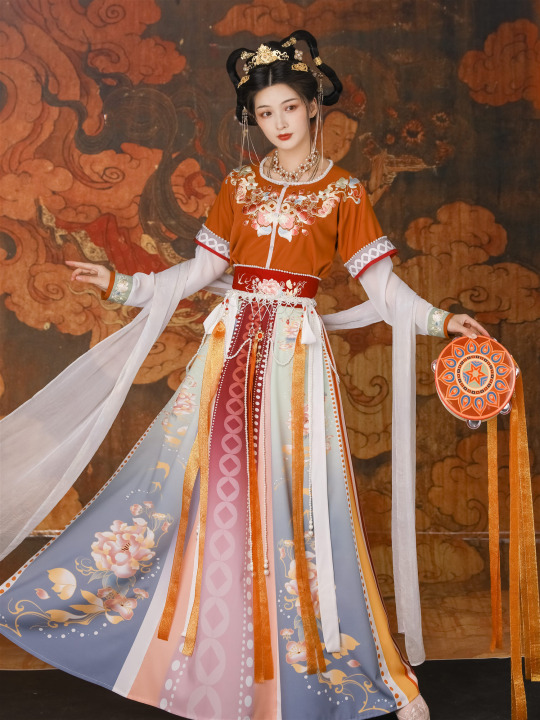
This particular hanfu outfit below has been tucked & draped in a non-traditional way to resemble Feitian clothing (x):
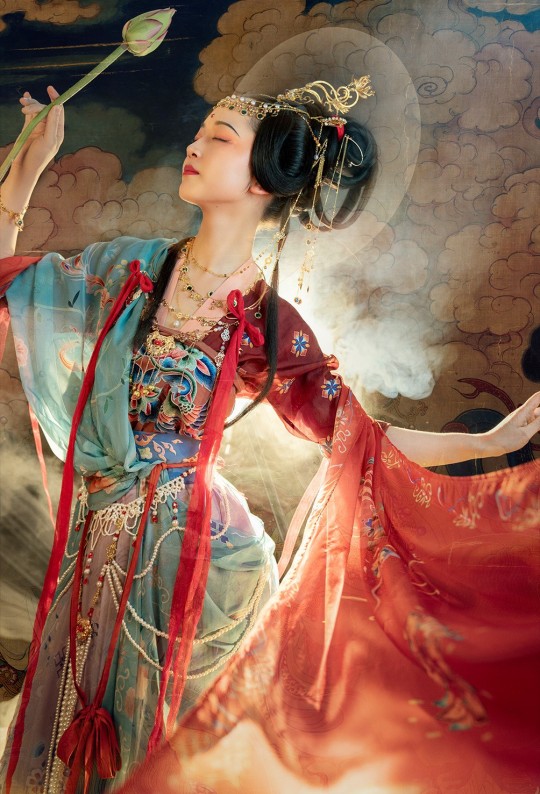
Now there is also a relatively new trend of recreating Feitian costumes closer to how they are depicted in the Murals. These costumes typically consist of items like bandeaus, pants, and scarves that are influenced by Indian clothing (which makes sense since Buddhism and apsaras came to China from India). Recently, it has become popular to have Feitian-themed photoshoots wearing such costumes. Below - examples of Feitian costumes (1, 2, 3):

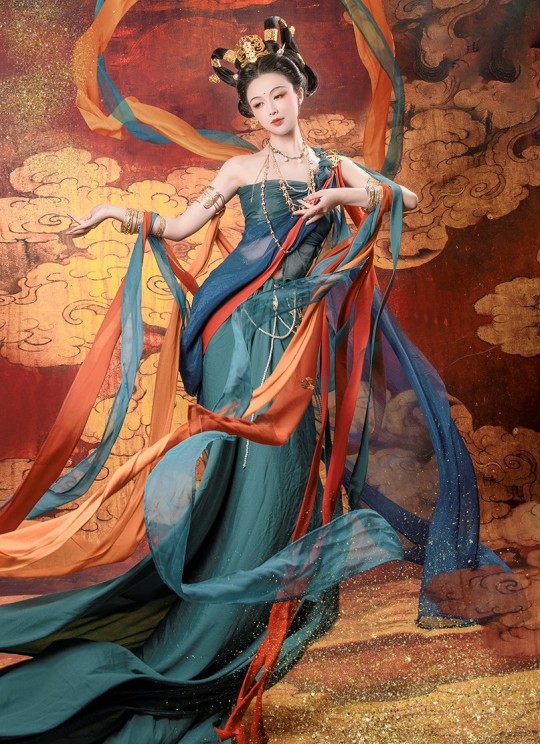
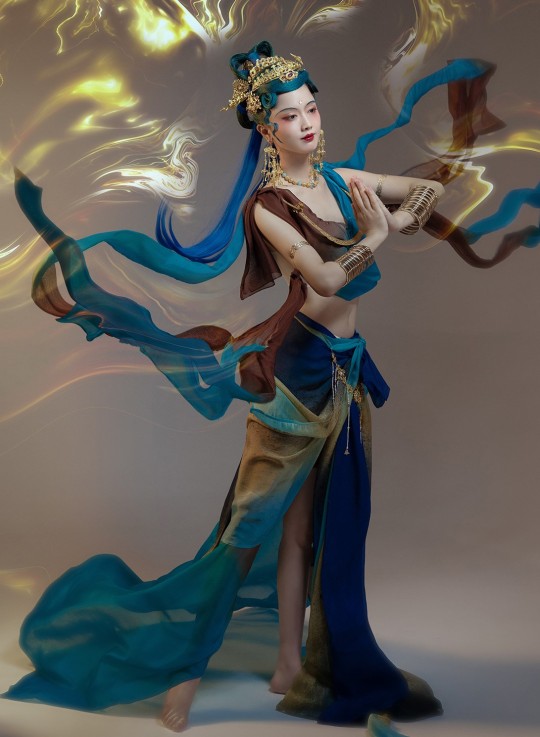
Note that Dunhuang-style Feitian costumes are not considered hanfu. They are in their own separate category, and are typically referred to as “Dunhuang Feitian Costume” (敦煌飞天服), or just “Feitian Costume” for short. They are usually only worn for dance, performances, or photoshoots. Nonetheless, like hanfu, they are a part of the broader trend of interest in historical & traditional fashion in China. Below - Left: Feitian-style hanfu, Right: Feitian costume (x):
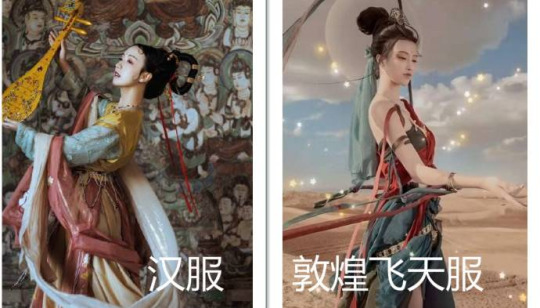
For more information and visual references, please check out my Dunhuang & Feitian tags, as well as the following posts:
@fouryearsofshades has two informative posts on Dunhuang/Feitian-style clothing here & here.
@siumerghe has a detailed post on the Dunhuang Murals here, as well as several posts on recreations of patrons’ clothing: 1, 2, 3, 4.
Hope this helps!
#hanfu#dunhuang#feitian#apsara#buddhism#recreation#feitian costume#history#reference#ask#reply#>1000#china#chinese fashion#chinese culture
4K notes
·
View notes